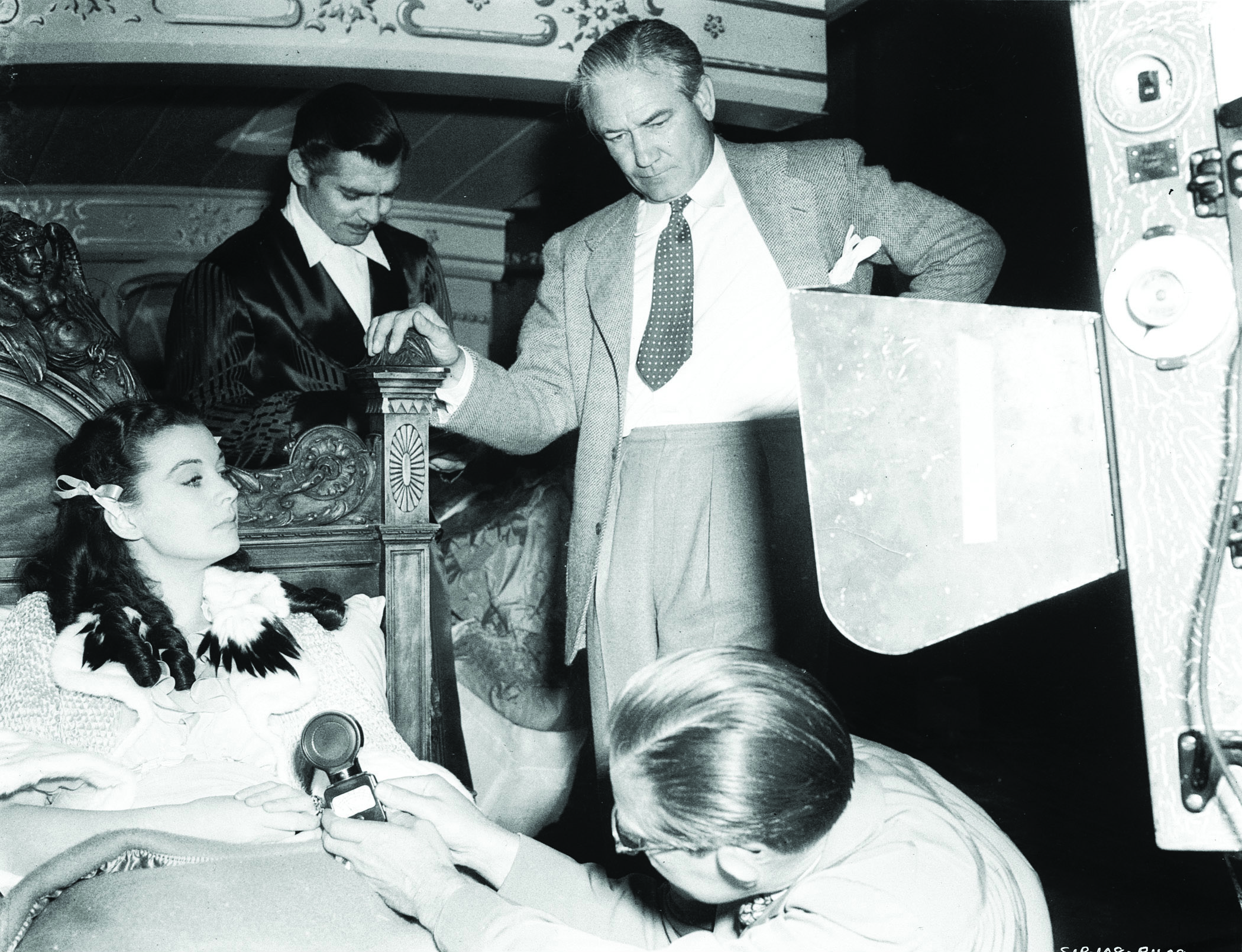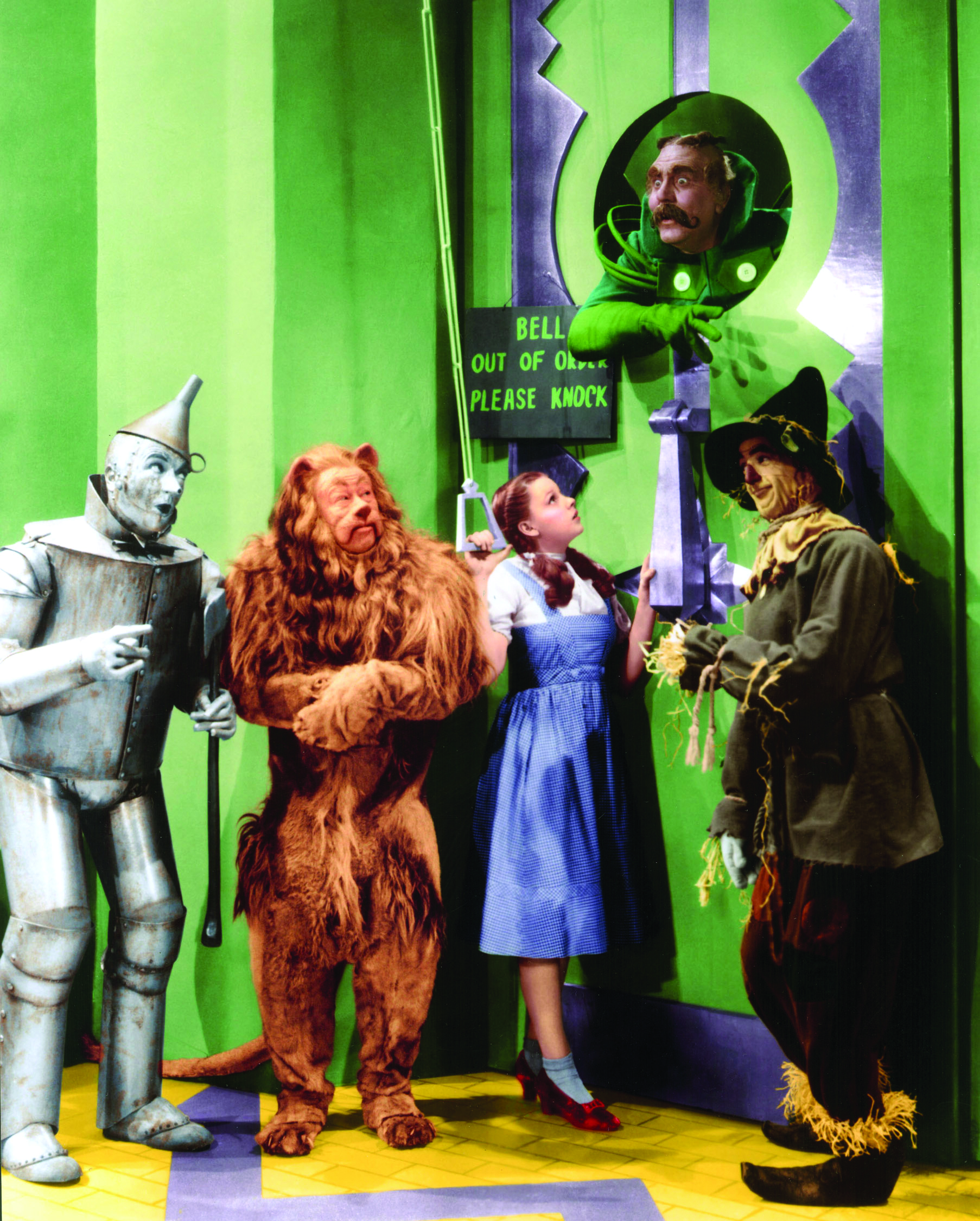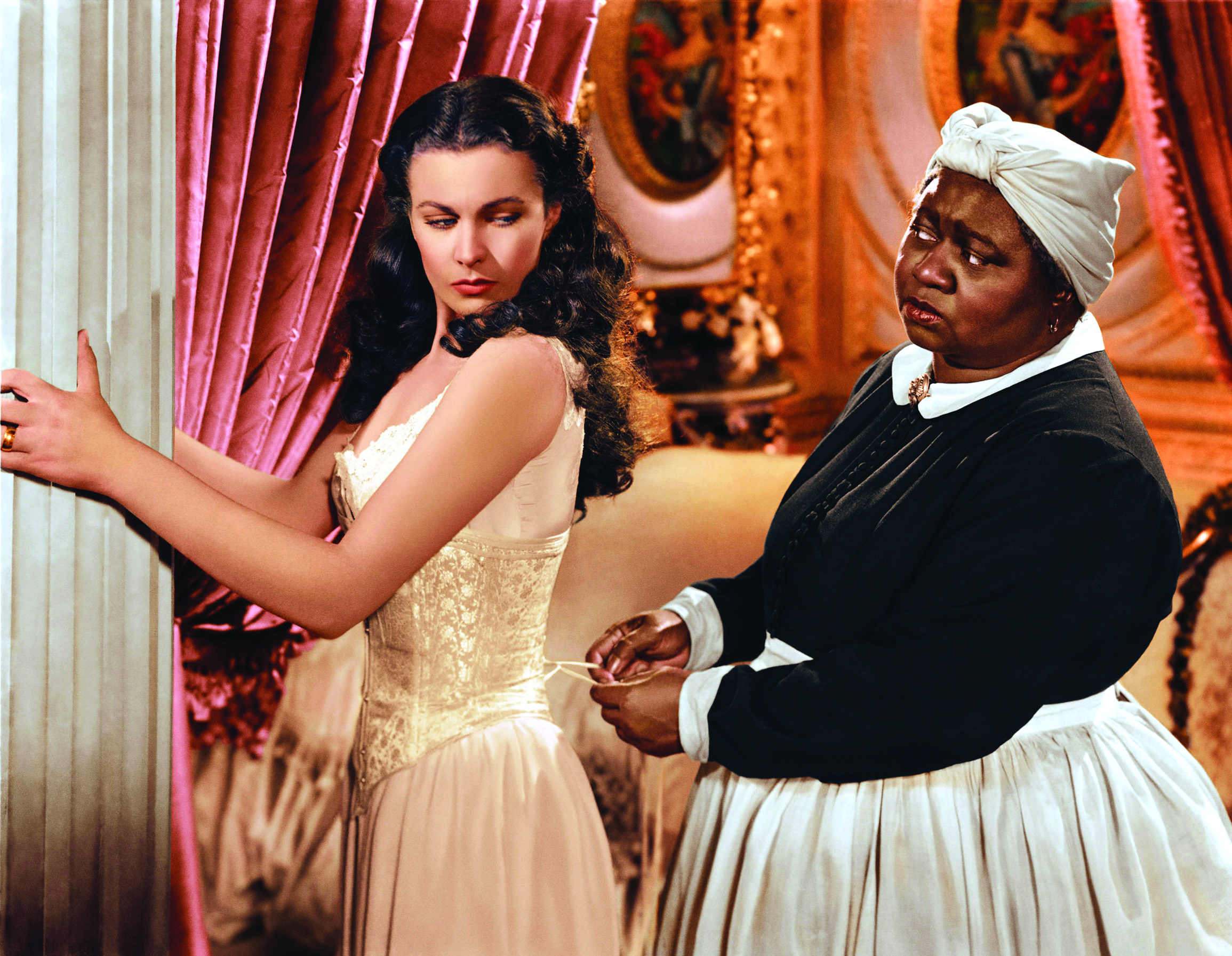BY GARY GIDDINS
 Fleming on the set of Gone with the Wind (1939). (Credit: Warner Bros.)
Fleming on the set of Gone with the Wind (1939). (Credit: Warner Bros.)
For the 70th anniversary of Hollywood's most fabled year, Warner Home Video released "Ultimate Collector's Editions" of the two movies that have come to best represent what film critic André Bazin famously called the "genius of the system": Gone with the Wind and The Wizard of Oz. Bazin's phrase is often trotted out to explain the directorial mystery that surrounds them both: Why is it that Victor Fleming, the director credited with two movies that have achieved unparalleled pan-generational popularity, is so little honored and respected in film history? Standard answer: Fleming was merely a cog in the system that made those pictures, one of the many hired hands assembled by authoritative producers—David O. Selznick and Mervyn LeRoy—for the factory-like studios of 1939.
Yet 2009 is proving to be a year of career rehabilitation for Fleming (1889-1949), whose frequently neglected contribution to Gone with the Wind is reconsidered by Molly Haskell in Frankly, My Dear: Gone with the Wind Revisited, and whose entire output is worshipfully evaluated by Michael Sragow in Victor Fleming: An American Movie Master. Inevitably, the case for Fleming is best made by his movies, and it's tempting to conclude that his reputation might have been more secure all along had he never been associated with those indelible titles. As Technicolor epics made virtually back-to-back, GWTW and Wizard look nothing alike; nor, at first glance, do they resemble much else in American cinema, including the rest of Fleming's work. Yet remove them from his filmography, and a distinct individuality becomes readily apparent.
In his two decades making talking pictures (he had already made some two dozen silents, many highly regarded in their day), Fleming helped to invent a certain kind of laconic hero and a correspondingly verbose heroine. He launched Gary Cooper and Clark Gable to stardom in The Virginian (1929) and Red Dust (1932), respectively, and piloted Jean Harlow through three films—Red Dust, Bombshell (1933), and Reckless (1935)—before eliciting a more intricate, though no less palpable sexual dynamism from Myrna Loy in Test Pilot (1938) and Ingrid Bergman in Dr. Jekyll and Mr. Hyde (1941).
Much has been made of Fleming's penchant for strong, silent males—the documentaries accompanying the 70th anniversary films refer to him, almost uniformly, as "a man's man" who bedded many women and smacked a few, in and out of public. But his way of working with women seems every bit as noteworthy, and perhaps had a more lasting impact. In the Harlow characters, Fleming unleashed a voluble, self-sufficient good girl/bad girl of a type later associated with Howard Hawks films. Harlow had been assertively sexy in William Wellman's The Public Enemy (1931) and Jack Conway's Red Headed Woman (1932), but under Fleming's guidance, her hard edges were replaced by a pneumatic, lovable sweetness. Fleming could not be accused of being a cog in the system that produced Harlow's breakthrough films: Red Dust and Bombshell were signed with auteurist finality as Victor Fleming Productions.
 THE WIZARD OF OZ (1939) (Credit: Everett Collection, Inc.)
THE WIZARD OF OZ (1939) (Credit: Everett Collection, Inc.)
When paired with Gable, Harlow's generous sexuality ignites more than a hint of the screwball romance patented two years later by Frank Capra (It Happened One Night) and Hawks (Twentieth Century). Paired with the relentlessly chatty, slightly effeminate Lee Tracy in Bombshell, she assumes the center of gravity as the bullied but fully up-to-the-challenge woman that would become a staple of 1940s comedies. Similarly, the enduring appeal of the patchy Test Pilot lies not in the camaraderie of Gable and Spencer Tracy, but in the emotional candor of Loy, who sizes up Gable as her ticket out of dullsville and charms him by assessing the virtues of her fiancé. The Harlow and Loy films—staples of home video on VHS and laserdisc, yet oddly unavailable on DVD—help to position Gone with the Wind in Fleming's canon. Despite the overdetermined Technicolor excesses, occasional longueurs, and chintzy process shots, not to mention the vile racism and historical malarkey, Selznick's mighty oak seems entirely in line with Fleming's emblematic approach to the deals that underlie romantic relationships—even if those deals originate, in this instance, in Margaret Mitchell's novel.
Haskell remarks, in one of the new GWTW featurettes, that Scarlett isn't brought to heel. Fleming's women rarely are. That goes not only for Vivien Leigh's Scarlett, but for Hattie McDaniel's remarkable Mammy, a performance invested with so much power, nuance, and wit—she gets one of the film's biggest laughs with just her voice, as she informs Scarlett from the unseen side of a closed door, "I told him you was prostrate with grief"—that she emerges, against long odds, as one of Hollywood's first power-wielding black women.
Other directors, including George Cukor and Sam Wood, had a hand in the completed picture, but Fleming's reliance on speed, melodrama, and suspense is a determining factor in the film's success. Even if you haven't seen the film in many years, you probably remember big moments like the crane shot of Atlanta's dead and wounded and Scarlett's raised-carrot vow never to go hungry again. But the film's momentum is sustained by Fleming's comparatively conventional set pieces, which establish relationships and ramp up the suspense. For example, there's the initial encounter at Twelve Oaks between Rhett and Scarlett over a hurled vase, the superbly edited sewing vigil (close-ups of eyes, mutual alertness, contrary concerns) as the women await the return of their vigilante husbands, and Rhett's alcoholic rapprochement with Mammy.
Fleming was recruited for GWTW in an emergency plea from Selznick, which meant pulling him off LeRoy's production of The Wizard of Oz before Fleming shot the scenes set in Kansas (later processed in sepia tone). Thus one of the most celebrated moments in the film, the tracking shot of Judy Garland singing "Over the Rainbow," was directed by King Vidor. Vidor shot about 15 percent of the release print, yet Fleming kept his hand on the tiller, supervising the cyclone, the editing, and sundry details. In a 1974 memoir, Mervyn LeRoy: Take One, LeRoy doesn't mention Vidor and refers to Fleming in passing (he was no more inclined to share credit than the notoriously self-promoting Selznick). He writes, "Fleming, always a great director, had that fantasy touch we needed"—no details given, though Fleming not only signed the film as sole director but received a Victor Fleming Production credit.
If Fleming had never previously shown much of a "fantasy touch," he definitely anted up on Wizard, redesigning the brick road and emphasizing its yellowness with blinding paint, and demanding a new song from Harold Arlen and Yip Harburg, "Follow the Yellow Brick Road." He controlled the ever-expanding Munchkin numbers like a besotted martinet; sanctioned matte paintings that remain breathtaking in their utter audacity (they are especially dazzling on the new DVDs); and engendered a banquet of life-changing performances. Of course, it launched a 17-year-old Judy Garland on a totemic, tortured ride to the pinnacle of American popular culture, and gave such dependable veterans as Frank Morgan, Billie Burke and the younger Margaret Hamilton roles for which they would be long remembered. More impressively, he did something no other director accomplished in preserving the irreplaceably eccentric theatrical gifts of Ray Bolger, Bert Lahr, and Jack Haley, none of whom would ever again get a comparable footing in movies. Although they spent many decades on Broadway and television, their many successes faded beside the eternal Scarecrow, Lion, and Tin Man.
Fleming's gift for musical fantasy may have been unexpected, but not his ability to probe the ambitions and uncertainties of childhood. Wizard defies time because it refuses to kneel to the children in the audience. Fleming had previously adapted two English classics that explored childhood from a boy's vantage point. Treasure Island (1934) and Captains Courageous (1937) are about how a boy becomes a man and how a man ought to raise a boy. Both involve substitute fathers—a pirate and a fisherman—and stick to the boys' perspective. Treasure Island totters a bit from Jackie Cooper's insufferably naïve Jim and the general Americanization of the casting, but the telling remains vigorous. The far more accomplished Captains Courageous, with its resilient performances by Spencer Tracy and Freddie Bartholomew (both films are available on exemplary Warner DVDs), has lost nothing to time. Seen in context with Wizard, one appreciates anew not only the parallel search for pedigree and maturity, but the more telling fact that there is absolutely nothing girlish or cute about Garland's Dorothy. (Consider what Wizard might have been if MGM had realized its initial casting choice: Shirley Temple.)
 GONE WITH THE WIND (1939) (Credit: Everett Collection, Inc.)
GONE WITH THE WIND (1939) (Credit: Everett Collection, Inc.)
After being nominated for the Golden Palm at Cannes for The Wizard of Oz and taking home the Oscar for Gone with the Wind, Fleming worked for another decade before succumbing to heart failure. Of his remaining films, his Dr. Jekyll and Mr. Hyde, with Tracy, Bergman, and a surprisingly self-effacing Lana Turner, plays best with a naturalistic, if juicily Freudian reading. Bergman's erotic vulnerability dislocates the story's emphasis from the two-faced protagonist to the cost of his depredations. Fleming had started out as a mechanic and was known as a man who could fix anything, knew every facet of moviemaking, and played for the team. The featurette on him included with Wizard finesses his artistry by calling him "Victor Fleming: Master Craftsman." But now that he is starting to get his due, it seems certain that as sure as Warner will find a technological justification to roll out 80th anniversary editions of its two most popular titles in 2019, by then their director will no longer be consigned to the shadows.